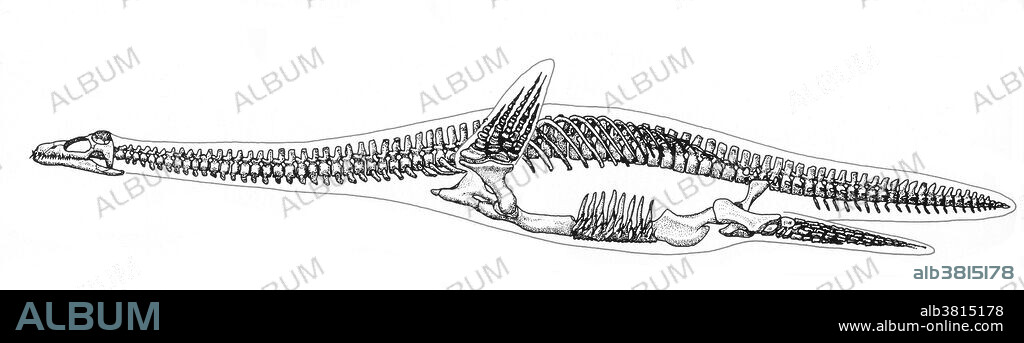alb3815178
Plesiosauria Skeleton, Mesozoic Reptile

|
Add to another lightbox |
|
Add to another lightbox |



Title:
Plesiosauria Skeleton, Mesozoic Reptile
Caption:
Plesiosauria is an order of Mesozoic marine reptiles. Plesiosaurs first appeared in the Early Jurassic Period and became especially common during the Jurassic Period, thriving until the Cretaceous-Paleogene extinction at the end of the Cretaceous Period. The typical plesiosaur had a broad body and a short tail. They retained their ancestral two pairs of limbs, which evolved into large flippers. All plesiosaurs had four paddle-shaped flipper limbs. This is an unusual arrangement in aquatic animals and it is thought that they were used to propel the animal through the water by a combination of rowing movements and up-and-down movements. There appears to have been no tail fin and the tail was most likely used for helping in directional control. They have been discovered with fossils of belemnites (squid-like animals), and ammonites (giant nautilus-like molluscs) associated with their stomachs. They had powerful jaws, probably strong enough to bite through the hard shells of their prey.
Credit:
Album / Science Source / New York Public Library
Releases:
Model: No - Property: No
Rights questions?
Rights questions?
Image size:
7050 x 1997 px | 40.3 MB
Print size:
59.7 x 16.9 cm | 23.5 x 6.7 in (300 dpi)
Keywords:
ANIMAL • ANIMALIA • ART • ARTWORK • BW • CHORDATA • CRETACEOUS PERIOD • CRETACEOUS • CRETACEOUS-PALEOGENE • DRAWING • EXTINCT • EXTINCTION • FAUNA • FOUR PADDLE-SHAPED FLIPPER LIMBS • HISTORIC • HISTORICAL • HISTORY • ILLUSTRATION • ILLUSTRATIONS • JURASSIC PERIOD • JURASSIC • LARGE MARINE REPTILE • MARINE REPTILE • MESOZOIC AGE • MESOZOIC ERA • MESOZOIC PERIOD • MESOZOIC TIME • MESOZOIC • OPPORTUNISTIC PREDATOR • OUTLINE • PALAEOBIOLOGY • PALAEONTOLOGY • PALAEOZOOLOGY • PALEOBIOLOGY • PALEONTOLOGY • PALEOZOOLOGY • PLESIOSAUR • PLESIOSAURIA • PREDATOR • PREDATORY • PREHISTORIC • PREHISTORY • REPTIL • REPTILE • REPTILES • REPTILIA • SKELETAL • SKELETON • TERRESTRIAL VERTEBRATE • VERTEBRATE • WILDLIFE
 Pinterest
Pinterest Twitter
Twitter Facebook
Facebook Copy link
Copy link Email
Email

